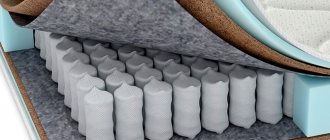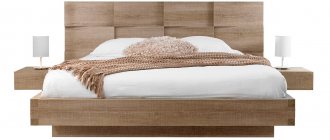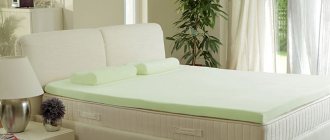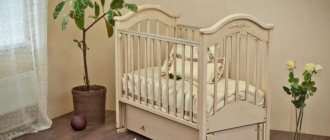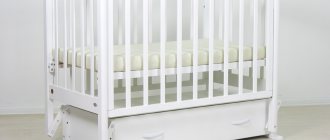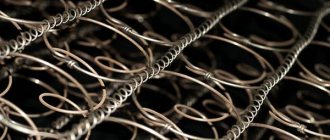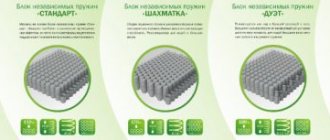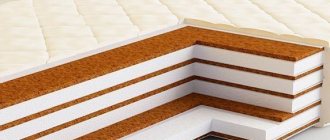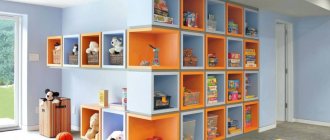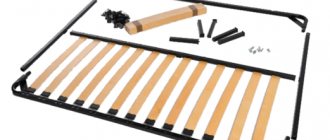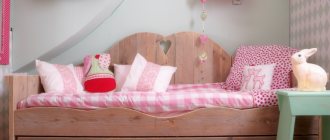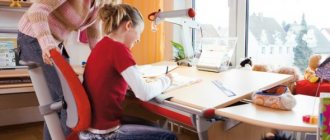Mattress size
Product width, length and height
The first thing you need to do to choose the right mattress is to take measurements from the crib: along the outer and inner perimeter. To avoid mistakes in the store, take a measuring tape with you, since all manufacturers label their products differently.
Basic parameters that allow you to choose the right mattress:
Length. It should be 10-15 cm larger than the child’s height. For younger ages from 3 to 12 years old, standard mattresses are suitable, the length of which ranges from 160 to 190 cm.
Width . It should be at least 2 times the width of the child’s shoulders. The width is usually from 60 to 120 cm.
Thickness _ The recommended parameter is from 15 to 24 cm. Keep in mind that the thickness of the mattress should allow the child to easily lie down and also easily get out of bed.
Special products are produced for newborns, the length of which is 95-120 cm and the width from 60 cm. Mattresses of these sizes provide reliable support for the baby’s spine. However, the sizes of cribs may vary, so when choosing, you need to base your choice on them.
Thin products are recommended for children who sleep on a sofa or folding chair. It is important that the dimensions of the mattress match the dimensions of the crib. Large gaps between the edge of the product and the sides lead to discomfort for the child while sleeping.
2.
Where to start choosing the right mattress
In order not to make a mistake with your choice, you should consider several factors. Namely:
- do not make a mistake with the size;
- select the desired degree of hardness;
- understand the characteristics of fillers;
- decide on the choice of cover material.
Reference! The concept of naturalness is not always synonymous with the concept of quality. For example, natural materials such as cotton wool, fluff, wool and, in some cases, even latex can cause allergic reactions in a child. Conversely, modern synthetic fillers in mattresses are completely hypoallergenic.
Design
With or without springs?
The key characteristic of each mattress is the presence or absence of a spring block. Looking ahead, it is worth noting that both types are suitable for a comfortable and complete rest.
On springs . They are not recommended for children under 3 years old, so they are usually purchased for preschool children and teenagers.
They are divided into several categories:
- With dependent spring block . Inexpensive models, but with little orthopedic effect. All springs are fixed in a steel frame, which ensures the safety of the resting child and prevents him from accidentally falling during sleep.
- With independent block . They are great for children who need spinal support (for example, with diseases of the musculoskeletal system). Among the disadvantages, it is worth highlighting the large weight of the products, which cribs are not always able to withstand.
Without springs . The interior of such mattresses is made of one or 2-3 layers of filler. It can be natural or synthetic. We recommend choosing mattresses whose design consists of a combination of several materials. Springless products are an excellent solution for newborn babies and children aged 1-2 years.
3.
Types of mattresses for children
The furniture market offers a wide variety of sleeping surfaces for children. They differ not only in cost and appearance, but also in orthopedic properties, hypoallergenicity, specific composition and filling. Depending on the age or individual characteristics of the baby, you have to settle on one option.
Foam rubber
When figuring out how to choose a mattress for a crib, you need to pay special attention to models made of foam rubber. Being an artificial material with good hypoallergenic properties, it is used not only for furniture production, but also for the medical industry. The key advantages of foam rubber products include a long service life if the rules of care are followed, good strength, and versatility. Depending on the degree of density, there are several types of filler:
- Standard;
- With increased rigidity;
- Soft and very soft;
- Special.
Rigid polyurethane foam
For newborn babies, the best mattress filling is hard polyurethane foam. It has the required degree of elasticity and provides favorable conditions for a child’s safe sleep. Staying on such a surface, the baby is protected from numerous problems with the spine, and also gets a good rest.
Models for babies are often equipped with waterproof mattress covers that protect the sleeping area from moisture. They also have good orthopedic properties, because... bend at the right points, ensuring that the correct proportions of the spine are maintained.
Latex
The ranking of the best children's mattresses also includes models made of natural latex. This material is created on the basis of hevea juice or rubber, therefore it is hypoallergenic and absolutely safe.
Other advantages of latex products include elasticity, resilience and strength. Also, such mattresses are moderately soft, protected from bacteria and dust, and durable. They are not afraid of exposure to moisture, and also quickly remove unpleasant odors.
Coconut fiber
Models of mattresses based on coconut coir are in particular demand. If the correct production technology is maintained, they have virtually no disadvantages, with the exception of the high price.
But you shouldn’t save on your baby’s health, because... affordable mattresses are often made from low-quality raw materials, which increase the risk of developing allergies and can release harmful substances during use. It is not difficult to distinguish natural fiber from cheap substitutes. Good material has a rich brown tint.
Combined mattresses
Combination mattresses may contain both natural and artificial fibers. But models from trusted manufacturers have the necessary characteristics and are ideal for use in a crib. They are protected from bacteria and dust mites, dry quickly, and also have good air exchange. The degree of elasticity is selected by the customer, which allows you to find the best options for children of different ages.
Spring children's mattresses
Sleeping surfaces with springs are made taking into account the anatomical structure of the child, so they have a good orthopedic effect. They are recommended for preschool children and teenagers.
Depending on the type of springs (independent or “bonnel”), the mattress can have a massage effect, protect the spine from deformation, and evenly distribute the load from the body over the surface.
When choosing a children's mattress, you need to be guided by both personal experience and expert advice. It is important to remember that the comfort of a baby’s sleep and rest directly depends on the quality of the surface on which it is placed.
Filler
Which filler is best for children?
The filler determines the hardness, elasticity and firmness of a children's mattress. Of course, for children it is better to choose natural “breathable” materials that do not interfere with the circulation of oxygen and can withstand even the highest loads.
The most common natural fillers:
- Latex . Advantages: firmness and elasticity. It provides excellent spinal support, which is why latex mattresses are often chosen for children from 1 year to 4-5 years;
- Coconut coir . Advantages: does not absorb moisture, hypoallergenic material. An excellent choice for children with an increased tendency to allergic reactions;
- Horse hair . Advantages: elasticity and wear resistance. Expensive material, used only in premium category mattresses.
Synthetic fillers are much cheaper than natural ones and easier to care for, but are not recommended for children under 3 years of age. They need to be changed every 6-7 years, because over time, some models lose their shape and sag under the weight of the child.
The most popular synthetic fillers:
- Polyurethane foam (foam rubber). Advantages: high elasticity and excellent breathability. Please note that the material does not cause allergies;
- Holofiber . Advantages: retains heat excellently, does not lose its qualities for a long time. The best choice for children aged 5-6 years;
- Memorix . Advantages: ability to adapt to body shape. Sleeping on a mattress with such filling will be as healthy and comfortable as possible.
4.
Fillings for children's mattresses
The softness, hardness, elasticity, and safety of the product specifically for children depend on the filler of orthopedic mattresses. Mattresses for little ones should be made from high-quality natural materials. But if a child is susceptible to allergies, then some natural materials can cause an undesirable reaction in him, and in this case, no less high-quality artificial fillers will come to the rescue.
In any case, the fillings of children's mattresses should not have harmful fumes, caking, and must maintain the qualities declared by the manufacturer throughout the entire period of service. The most popular materials for filling children's mattresses are coconut fiber, polyurethane foam, and natural latex.
Orthopedists and pediatricians assure that a coconut mattress for a child is a guarantee of proper growth of the skeletal system and the full development of the child’s body
. Let us clarify that the name “coconut mattress” does not always mean that it is made from coconut coir alone. In a high-quality coconut mattress, a proven design is combined with fillers selected exactly for the intended purpose of this product. A coconut children's mattress from good manufacturers will evenly distribute the load on the spine and ensure a restful sleep for the child.
Coconut fiber contains lignin, a natural polymer that gives it elasticity, protects it from rotting and does not allow it to absorb moisture. In addition, coconut mattresses are perfectly breathable and ventilated, which guarantees that the microclimate inside the mattress is correct. Coconut coir is hypoallergenic, which means it is safe for children.
Note that coir can be different. Products with shredded coconut coir are cheap, but after a couple of months you may notice that the mattress has gone into “waves.” To protect yourself from counterfeits and low-quality products, do not buy dubious products from fly-by-night manufacturers, purchase a proven coconut mattress for your baby with all hygienic reports and quality certificates.
Latex
- This is a high-quality natural material. It is obtained from the sap of the tropical Hevea tree. Natural latex has a cellular structure, thanks to which it springs perfectly and restores its original shape. This material structure also provides it with excellent ventilation and air permeability. Latex is endowed with hypoallergenic, antifungal and antibacterial properties; it does not absorb moisture, does not absorb dust and does not rot. Micro-mites do not form in latex; its ability to retain and quickly restore its shape makes latex an excellent orthopedic filler for children's mattresses.
Coconut mattresses with latex
have medium hardness. Such mattresses for children are not only comfortable, but also hygienic. Latexed coconut coir is made from more expensive and high-quality raw materials. To briefly describe the process, coconut fibers are compressed and impregnated with natural latex, after which a durable, dense and elastic material is formed. A coconut mattress with latex filling exactly follows the contours of the human body, so this mattress will ensure your child a healthy, sound and deep sleep.
Polyurethane foam
, abbreviated as PPU, also known as artificial latex, was created with the aim of reducing the cost of natural latex. Of course, the latex analogue is not as good as expensive natural material, but it is still worth paying tribute to polyurethane foam and recognizing that in its properties it is very close to natural latex. Polyurethane foam does not cause allergic reactions, it is environmentally friendly and fireproof. Like latex, polyurethane foam has a cellular structure and each cell acts as a mini-spring. This material “breathes” freely, provides a good orthopedic effect of hardness/softness in the desired areas, protecting the child’s spine from curvature.
But what you should avoid are foam rubber or cotton mattresses
. These fillers are soft and not elastic enough, and they also absorb moisture well, creating a favorable environment for the development of bacteria. Cotton wool and foam rubber are easily dented and destroyed. On such a mattress, the baby will not receive proper orthopedic support. The only advantage of cotton and foam mattresses is their low cost. However, experts agree that it is better to add a little and buy the most budget-friendly coconut mattress. It will be much more useful for the child.
View the catalog of children's mattresses
Upholstery
What should the cover be like?
We recommend choosing mattresses whose upholstery is made of durable fabric. Basic requirements: strength, wear resistance and breathability. Mattresses for children can be upholstered from natural materials: cotton or linen.
There are also products on sale with artificial fabrics, the most widespread of which is polyester. It does not absorb moisture at all, is easy to care for and is affordable.
Combined upholstery is the best option if your financial capabilities are limited. Children's mattresses with jacquard (composition: cotton threads and polyester fibers) are presented in the lines of most domestic manufacturers.
Regardless of the material, the product cover can be removable or non-removable. We recommend choosing the second option, as it guarantees a tight fit to the mattress. Take a mattress cover in the kit; unlike the removable cover, it can be easily washed at home.
5.
Rigidity
Which option should I choose for my child?
The main function of a children's mattress is to ensure the correct position of the spine. In total, there are 3 groups of products: soft, medium-hard and hard models. Only the last two types are suitable for children; the first is not allowed.
Hard mattresses . An excellent solution for newborn babies, children aged 2-3 years, as well as children with diseases of the lumbar spine. The filler in such products is latex or holofiber.
Medium-hard . They are recommended for ages 3 and up, so they are considered universal products. Typically, several materials differing in degree of rigidity are used simultaneously as fillers.
Note! If your baby has spinal diseases, be sure to consult a doctor about the hardness of the mattress.
6.
How to choose the right mattress for a child?
When deciding how to choose a mattress for a child, you need to take into account a number of factors:
- the rigidity and characteristics of the filling material must correspond to the needs of the child’s age and weight;
- environmental friendliness and breathability of the coating material (upholstery);
- the dimensions of the mattress and crib must perfectly match each other;
- when buying a model for a child with allergies, you need to consult a doctor, and when purchasing, check the list of all components included in the composition and make sure that there is a certificate for the product;
- when a child has serious health problems, the choice requires consultation with a pediatric orthopedist.
When choosing a mattress for a child, you need to consider the above factors.
Which mattress should I choose for a child over 3 years old?
Unlike an infant, who needed a thin mattress with a hard surface, starting from 3 years old, a product with good anatomy (a surface that follows the contours of the body) is required. This means that we are talking about a moderate or medium degree of hardness:
- High-quality spring design (budget option);
- Either springless - monoblock or “puff” model
Versatility
Single-sided or double-sided mattresses?
The predominant part of mattresses are single-sided, but some manufacturers offer double-sided products. Their peculiarity is the type of coating that can be used comfortably at any time of the year. For example, the “winter” side of the mattress is distinguished by a soft filler and a layer of natural wool, while the “summer” side is upholstered in hygroscopic fabric that ensures unhindered air circulation.
Double-sided mattresses are a great choice for children, regardless of their age. If your financial capabilities allow, we recommend taking just such a model.
7.
Orthopedic mattress
Are orthopedic properties necessary?
If a child has diseases of the musculoskeletal system, we recommend purchasing an orthopedic mattress. Its cost is higher than that of standard products, but the design provides maximum support for the spine and reproduces the contours of the body.
For healthy children, an orthopedic mattress will serve as the best prevention for almost all diseases associated with the motor system. Please note that most of these products are equipped with an independent spring unit, so they are not suitable for newborns.
8.
Which mattress to choose for a children's bed by age
According to doctors, it is advisable for an adult to sleep about 8-9 hours a day. Children's standards are higher. For example, Rospotrebnadzor recommends that elementary school students have 10–10.5 hours of rest at night, middle school students at least 9.5, and only high school students are subject to “adult” indicators.
Taking into account the fact that the youngest member of the family remains asleep for quite a long time, one should not take such a purchase as a mattress for a children's bed lightly. How to choose it so that the baby’s skeleton and internal organs are formed correctly?
Doctors say: sleeping in bed on an uncomfortable mattress does not allow you to relax your muscles; this can cause scoliosis, problems with blood circulation in the neck and, as a result, headaches. To choose a suitable mattress for a children's bed, you need to take into account the age of the child:
- Infants and children under 3 years old
can choose coconut coir, as they prefer to sleep on firm mattresses without springs with environmentally friendly filling. - For the age group from 3 to 7,
it is better to choose a mattress with medium hardness. Very hard surfaces are not suitable: children in these years begin to grow rapidly, their musculoskeletal system is formed. In addition, a bed for preschoolers is a place intended not only for sleeping, but also for playing. And you won’t have much fun on a surface that’s too hard. It is preferable to choose springless or moderately hard spring mattresses. - For a schoolchild’s bed,
it would be good to choose a double-sided orthopedic mattress that “knows how” to adapt to a growing body, the contours of which are changing.
This is interesting!
The word “mattress” comes from the Arabic materas – “to put”. Researchers believe that the mattress dates back to the Neolithic period. At that time, it was a cover made of goat or bull skins, filled with dry grass. In the Middle Ages, products were filled with straw, wool or horsehair; the Renaissance was the era of using feather and down as filler. In 1900, the spring mattress was invented.
Age
How to choose a mattress based on age?
When choosing a children's mattress, be sure to take into account the age of the child, since this is what determines the developmental features of the musculoskeletal system:
Up to 2-3 years. The best solution would be rigid products, since during this period of time the baby begins to develop the correct curvature of the spine and the musculoskeletal system. On a soft product, the skeleton will not receive sufficient support, and the likelihood of curvature will significantly increase.
For 3, 4, 5 years old. Doctors recommend giving preference to models of medium hardness, while the internal filler can be coconut or latex. If your child likes to play or roll around in the crib before going to bed, then the chosen model should be resistant to high loads.
From 6-7 to 12 years. You can choose not only springless mattresses, but also products equipped with an independent block. There are no restrictions in the choice of filler, but the product must be thicker than those used at an earlier age. The recommended level of hardness is medium.
Before purchasing a children's mattress, make sure that the product is certified and free of specific odors.
9.
Coconut mattresses for children
The list of the best children's mattresses includes models made from coconut coir. This filler is characterized by a natural composition, long service life and moisture resistance. In addition, they have increased rigidity and rarely cause allergies.
However, recently people have started to look at braid fiber with skepticism. This is explained by the introduction of synthetic additives into the composition, which eliminate the disadvantage of rapid crumbling and deformation, but deprive the material of its naturalness. In addition, budget mattress models may contain toxic components that cause an allergic reaction and emit a persistent rubber odor.
If you want to buy a coconut fiber mattress, you should give preference to products from trusted brands that provide quality certificates.
Manufacturer
Brands you can trust
Choose mattresses for children only from reliable Russian or foreign manufacturers. If you decide to save money and buy a product from a little-known brand, then be sure to request a Certificate of Quality!
Companies you can trust:
- Askona . A Russian manufacturer whose collections include spring and springless mattresses;
- Mediflex
. A domestic company specializing in the production of orthopedic products with various fillers; - Dormeo . An Italian brand offering a huge selection of mattresses made from natural materials for children;
- IKEA . A Russian company that produces products of consistently high quality at very attractive prices;
Other brands offering comfortable, safe and high-quality mattresses include: DreamLine, Peligrin, Lance Elin, Violite, Sakura, Ormatek.
10.
What is better for a child: springs or filler?
The classification of children's mattresses is similar to those for adults. They are divided into two large groups: spring and springless. Which ones are recommended for use in cribs?
The choice depends on the age of the child. For newborns and children under three years of age, hard surfaces are recommended. Typically, a springless coconut fiber mattress is purchased.
Children between three and seven years old can sleep on softer surfaces. Spring and springless mattresses have a medium degree of elasticity.
Which one to buy for your child is up to the parents to decide. The main selection criteria should be the quality characteristics of the materials.
Price
Budget or premium?
Russian and foreign manufacturers offer such a huge selection of children's mattresses that you can easily find a high-quality product that is perfectly affordable. For example, a mattress with natural linen upholstery and orthopedic foam flooring from Askona can be purchased for RUB 10,990. The same mattresses from Ormatek, equipped with a system of independent springs, cost a little less - 7,490 rubles. If you are looking for models that are lower in cost, then pay attention to the products of the Russian brand “Sakura”. It offers children's mattresses with coconut fabric for only 6,940 rubles.
Similar mattresses from foreign manufacturers will cost more – from 10,000 rubles. and higher. In their production, innovative technologies and exclusively natural materials are used. The upper price threshold is not limited and can reach several hundred thousand rubles. Keep in mind that springless mattresses are 30-35% more expensive than products with springs.
to contents
